
[cmamad id=”20868″ align=”center” tabid=”display-desktop” mobid=”display-desktop” stg=””]
This phenomenon is still going strong after it began during the Vietnam war… Have you heard about this?
—–Important Message—–
Remember as a kid, when you ate pizza, sub sandwiches, and anything else? And you were rail-thin, right?
Here’s how to get that back…
Have you noticed that the less you eat the MORE you gain?
No kidding. At this point, us guys can eat nothing but air and gain pounds!
It’s real – and it’s because our metabolism has gotten really cold, really low, and really slow.
Even a small number of calories cause us to get still more belly fat.
And along with that, our libido tanks and our sexual performance falls into the gutter.
BUT… I’m sure you can remember as a kid, when you ate pizza, sub sandwiches, and anything else and were rail-thin, right?
And you were getting woodies and semis – and just couldn’t shake that horny feeling ALL the time. Remember?
The difference between then and now… it’s metabolism. Yours and mine are TOO slow, low, and cold.
It turns out that if you can WARM and LIFT your metabolism, you eat anything you want and still lose fat and …
And, even better, your penis starts doing somersaults like it did when you were a young man.
No kidding, it’s pretty sweet to have woodies and semis all day long like you used to…
Of course, Big Pharma is working on this…
But guess what?
There already IS a simple and direct way to raise your metabolism and roll back the clock… without using dangerous Big Pharma chemicals…
And it’s FREE for you today.
I call it my Youth Protocol. You are warmer, more energetic, more youthful, and hotter – in and out of bed, LOL.
———
Glutamania – don’t believe the hype
Of all the common food additives, not one has been trumpeted about more than monosodium glutamate.
This is quite unfortunate, really, as MSG is just an amino acid that is associated with a sodium ion – in the dry state.
When MSG is hydrated, like when it’s in food or water, the two ions dissociate and become free sodium and free glutamate.

Using glutamate to enhance the taste of foods began shortly after 1908.
That’s when a Japanese chemist found out it is responsible for the umami taste of kelp-based soups.
And, of course, people were using the sodium ion long before that.
Kelp is a sea plant with a high sodium to potassium ratio…
[cmamad id=”20869″ align=”center” tabid=”display-desktop” mobid=”display-desktop” stg=””]
Therefore, sodium glutamate is the primary compound that condenses when miso soup evaporates (yet potassium glutamate is also available).
Free glutamate is in many foods naturally – most notably tomatoes and mushrooms.
And, because it’s the most common amino acid, we eat it in great quantities in the protein-bound state.
“It is ingested at an estimated daily level of 38-40 gm in protein. Only somewhere between approximately 1 and 10% is in the form of free glutamate.”
Even though we glutamate need as a precursor to enzymes, structural proteins, and neurotransmitters (e.g. GABA and pyroglutamate), it has a reputation of being “toxic” among the more indiscriminate food additive fearmongers.
Don’t get me wrong, there are dozens of food additives that you should strictly avoid.
However, MSG should be the least of our concerns.
Our bodies synthesize glutamate from glutaric acid (a product of the citric acid cycle), and we simply could not live without it.
But the first reports of MSG reactions surfaced before scientists understood that glutamate is a neurotransmitter… So they misunderstood the minor effects it does induce in large doses right from the start.
This happened during the Vietnam War years, around the time that American xenophobia against all things Asian was escalating.
“Monosodium glutamania” officially started in 1968, after a personal anecdote penned by Dr. Robert Ho Man Kwok appeared in The New England Journal of Medicine.
The article was called “Chinese Restaurant Syndrome” and described the symptoms as:
“…the triad of ‘numbness at the back of the neck, gradually radiating to both arms and the back, general weakness and palpitations.’ and surmised that monosodium-L-glutamate could be the cause…”
Later in 1968, a New York Times article entitled “Chinese Restaurant Syndrome Puzzles Doctors” primed the public to blame any restaurant-based discomfort specifically on MSG.
The Tet Offensive was “initiated earlier that year” and so the time was ripe to scapegoat any Asian food additive…
Maybe as retribution?
The press brought hundreds of case reports out of the woodwork leaving no symptoms left unreported…
Burning, facial pressure, chest pain, headache, nausea, abdominal pain, substernal burning, diaphoresis, palpitations, and asthma were all blamed on MSG.
Yet most of these symptoms are classic reactions to sodium metabisulfite, not glutamate…
Pure MSG used in controlled laboratory settings has never replicated even a fraction of those symptoms we associate with “Chinese restaurant syndrome” – even in massive 10-gram doses.

This Italian study was the first to use a double-blind technique in an MSG experiment (double-blind eliminates eliminating experimenter bias).
Also, this study was conducted in Milano, by Italians, so that also eliminated nationalistic bias – Italy remained neutral throughout the Vietnam War.
They gave 24 subjects a substantial dose (3 gm) of MSG in soup.
After that, the subjects ate whatever MSG-free food they wanted to.
This was a crossover-designed study (each subject was tested twice to help ensure fidelity and increase statistical significance).
But they hardly needed the calculations because the results were a perfect tie:
The placebo group reported symptoms with the exact same frequency as the MSG group:
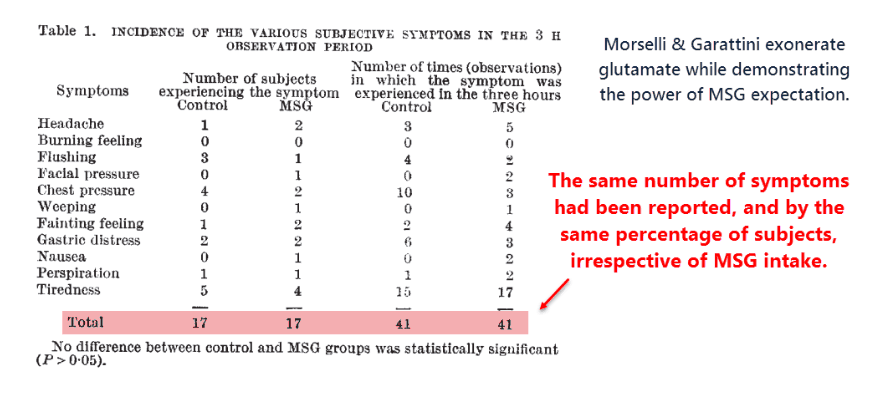
They also measured blood pressure and heart rate – and found no difference between the two groups in those more objective parameters.
“It should be emphasized that nobody, either in the control or the MSG group, experienced that burning feeling which is typical of the ‘Chinese restaurant syndrome.’”
This data seems almost comical when juxtaposed against the glutamania that still exists in America.
Most non-Asian meals already contain about 1 gm of free glutamate, on average, with another 4–6 gm perhaps being obtained via Chinese food.
Here’s another interesting finding about the study:
The placebo group reported more symptoms than the MSG group in the second phase of the experiment, the phase designed to investigate time of onset:
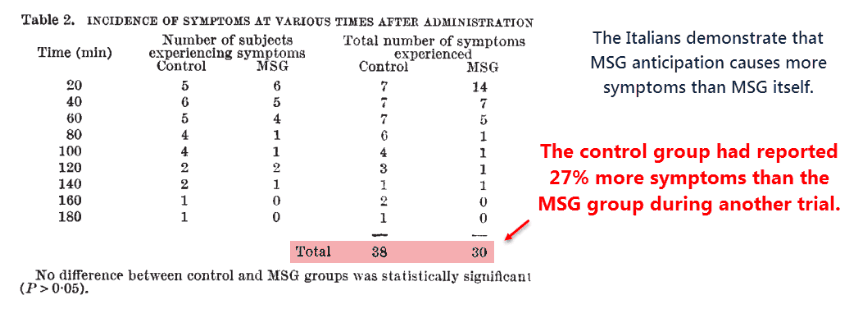
Yet glutamate is a neurotransmitter, so some true responses can sometimes be teased out using large MSG injections.
But, technically, glutamate may have to become cyclized to pyroglutamate before it can be rightly called a neurotransmitter.
Pyroglutamate can cross the blood-brain barrier – and about half of all plasma glutamate is found this cyclic form.
Yet, when MSG is given with food, its absorption is greatly delayed.

This leads to very high oral tolerance…
And that’s why the subtle reactions that can truly be blamed on glutamate alone happen after someone eats MSG-laden soup on an empty stomach.
“Wonton soup, prepared without it, did not provoke symptoms, and it was the only component of the soup which did cause symptoms.”
Of course, differences in food preparation don’t necessarily explain why only a minority of people report symptoms, but the article that follows certainly does.
Supplementing with vitamin B6 has been shown to eliminate all MSG reactions in the small minority of people who truly experience them…
Vitamin B6 is an essential cofactor in numerous transaminase enzymes that can rapidly transform glutamate into other nonessential amino acids – such as alanine, aspartate, and glycine.
And it does this reliably:

After having a few insightful thoughts about glutamate, Karl Folkers performed this study.
He screened 53 students for the activity of serum aspartate transaminase, a B6-dependent enzyme that converts glutamate to aspartate.
He gauged the degree of B6 deficiency by testing the enzymes’ activity before adding the vitamin – and then again afterward.
The difference in activity represents the amount of enzyme that had been present, devoid of its pyridoxine cofactor (vitamin B6).
Then he selected 27 of the subjects most deficient in B6 to partake in an MSG challenge.
After concluding that a 4-gm dose of MSG would give unreliable results, he decided to use a 6-gm dose.
(Incidentally, the 4-gm dose is the “Panda Express dose” and the 6-gm dose is the “Happy Wok dose.”)
Out of the 27 students most deficient in B6 – roughly half of the initial group – 12 of them reacted…
That’s a fairly high percentage for that dose level.
Then he gave ¾ of those people a B6 supplement for 12 weeks (and the others a placebo) and retested.
As a double-blind study, not even the experimenters knew which subjects were getting what until the results were in.
The three patients who got the placebo reacted again to the 6-gm dose of MSG.
But all of the B6 group (except for the one most deficient in B6 to begin with) remained entirely free of symptoms:
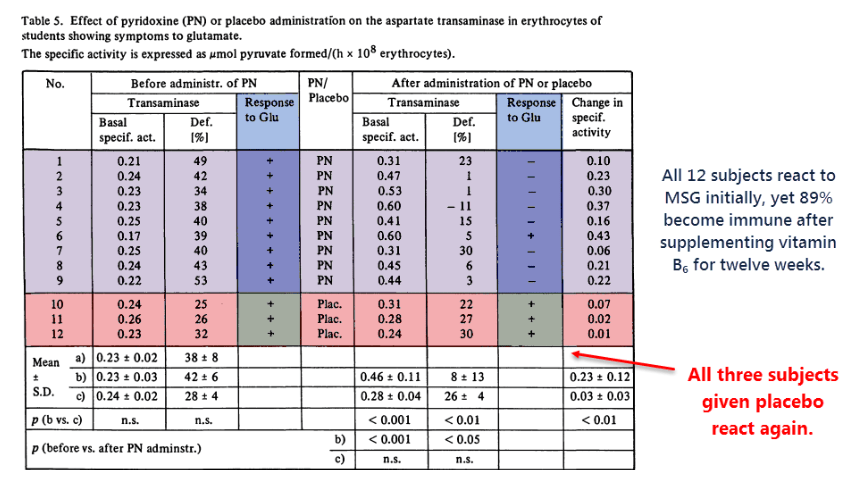
All this makes perfect sense biochemically, as a good amount of glutamate is transaminated before it even enters the circulation.
Vitamin B6 is the cofactor for multiple transaminase enzymes – aspartate transaminase being only one example.
This 89% reversal rate is very convincing.
“…‘Chinese restaurant syndrome’ to oral glutamate failed to reoccur after treatment with pyridoxine…the biochemistry of vitamin B6 is basic to the cause of ‘Chinese restaurant syndrome.’”
And the symptoms that were reported were mild…
The ionotropic glutamate receptors will cause a few sensations upon activation, such as warmth, and have been detected peripherally in the human body.
This is not an allergy of any kind whatsoever, but merely an unbalanced amino acid condition.
Neither histamine or acetylcholine is needed to explain the effect of glutamate because it’s now known to have its own receptor.
Most of the symptoms that actually occur are innocuous…
In laboratory settings, glutamate never causes all the symptoms attributed to it – especially the respiratory symptoms.
Glutamate might actually be expected to improve breathing, perhaps dilating capillaries in the lungs as it does with those in the brain.
The food additive that causes the remainder of “Chinese restaurant syndrome” is certainly sodium metabisulfite:

Unlike monosodium glutamate, sodium bisulfite is a more universal food additive.
This is a very ubiquitous substance in America and not really characteristic of any particular ethnic food type.
Yet, if you’ve ever read labels at an Asian grocery store, you’d know that sulfites are in nearly every can and jar.
Sulfites are far more potent and dangerous than glutamates gram-for-gram…
And restaurant food is notorious for having high amounts of sulfites.
“Consequently, estimations are that 2 to 3 mg of sulfites are consumed each day by the average citizen in the United States. Additional consumption of 5 to 10 mg of sulfite per day occurs in wine and beer drinkers… A customer can ingest 25 to 100 mg of metabisulfite in one restaurant meal.”
Yet sulfites have never been the focus of a media frenzy.
This could be because “sulfite sensitivity” doesn’t have the same ring that “Chinese restaurant syndrome” does.
Or maybe it’s because sulfites are used by every American food, beer, and wine industry of any significance.
And who controls the media?
Nobody has ever been concerned about losing advertising where MSG is concerned.
Back in the 1970s, there was no single Chinese restaurant franchise that could afford a mention in The New York Times anyway…
And the war – don’t forget about the war.
“…a 35-yr-old white [sulfite sensitive] female executive, has had perennial asthma since childhood. In 1972, immediately after a meal in a school cafeteria, she developed a generalized flush, faintness, weakness, and chest tightness, with severe wheezing and dyspnea…”
Glutamates are safe as measured by the gram, while sulfites are dangerous in the milligram range.
This is because the sulfite ion spontaneously becomes a free radical in water, inducing lipid peroxidation and binding free thiols.
(Thiols are the sulfur analog of alcohols – sulfur takes the place of oxygen in the hydroxyl group of alcohol).
Many enzymes, cofactors, and coenzymes are thiols and thus putative targets of sulfites.
Enzymes that are dependent on thiamine, biotin, glutathione, lipoic acid, pantothenic acid, and coenzyme A are all compromised by sulfites.
In my opinion, sulfites are the best explanation for why alcoholics tend to be low in thiamine.
Thiamine has been shown to increase sulfite tolerance eightfold in humans, perhaps by binding it in the liver.
“None of the patients experienced nasal symptoms, and all four patients noted systemic symptoms (flushing, tingling, and/or faintness).”
Our biological defense against this class of food additive is called sulfite oxidase, a molybdenum-dependent enzyme that turns it into harmless sulfate.
Deficiency in molybdenum confers sulfite sensitivity – that’s similar to how a deficiency in vitamin B6 reveals a latent glutamate sensitivity.
We need molybdenum for three separate enzymes. But nobody ever talks about that…
Maybe because nobody can figure out how to pronounce it.
Sulfite sensitivity is the classic restaurant syndrome…
It’s just never been sensationalized by the media.
“We have recently identified four asthmatic patients who are exquisitely sensitive to ingestion of potassium metabisulfite in concentrations frequently found in restaurant meals…Systemic symptoms did occur, but these were tingling, flush, and hypotensive symptoms.”
In an aqueous environment, sulfite exists in equilibrium with sulfur dioxide…
And this gas essentially recreates all of the symptoms we get from sulfite ingestion.
As a gas, the primary symptoms of sulfur dioxide poisoning (and its sulfite precursor) are respiratory in nature.
That’s because the lungs are the primary organs of gas exchange.
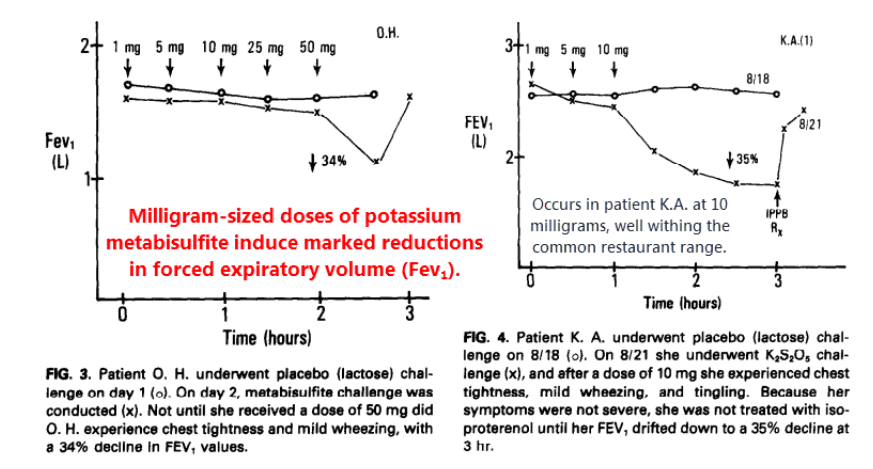
Contrast this with the effects of monosodium glutamate, an amino acid salt which has no reproducible effect on forced expiratory volume (see Fev1 in the graphic above).
“These findings are consistent with those of Schwartzstein et al. and Germano et al., who also failed to detect MSG-induced asthma in adults.”
MSG had no effect, not even in asthmatics who claimed to have MSG reactions before this study:
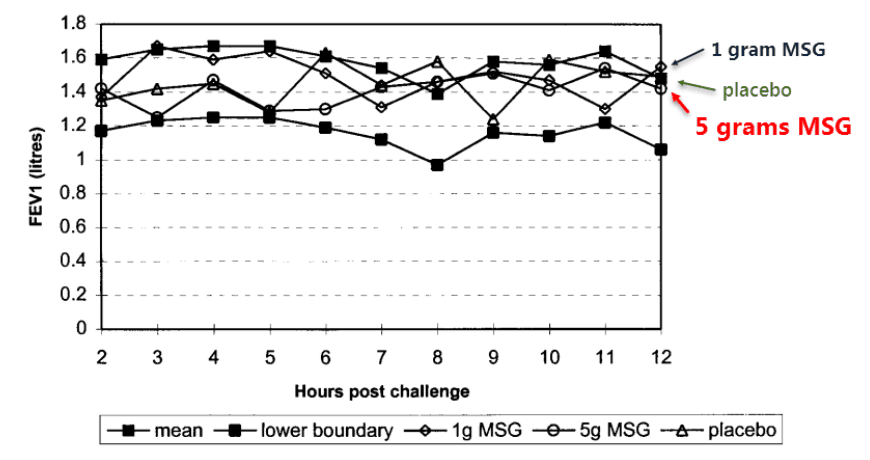
And thus “Chinese restaurant syndrome” really does seem to have another cause, as prophesied by Dr. Gore in his 1980 Lancet article, “Chinese Restaurant Syndrome: Fact or Fiction?”
“Although reactions to MSG were significant, the symptoms recorded were not those of the ‘Chinese restaurant syndrome’. There was no dose-related effect of MSG… We feel that if the ‘Chinese restaurant syndrome’ exists it is due not solely to the ingestion of MSG but…to a combination of MSG with another as yet unrecognized substance or to the ingestion of something entirely different.”
All of the purported symptoms of “Chinese restaurant syndrome” that cannot rightly be explained through monosodium glutamate are explained by sodium metabisulfite…
And the other reason for “monosodium glutaphobia” is the studies on excitotoxins – particularly the ones showing brain damage in infant rats using massive doses of glutamates.
Yet these same changes do not occur in adult rats at any dose – nor can they be induced in primates.
Moreover: The massive amounts of glutamate given in the classic baby rat studies were given intravenously…
That’s the only way to achieve doses high enough to induce the effects peculiar to that species.
“Chronic feeding studies [using glutamate] in a variety of species including dog, rabbit, and monkey at dietary levels ranging from 0.1% to more than 40% by weight have been consistent in showing no neurological lesions even though daily intakes as high as 42 g/kg body weight were achieved.”
There is nothing exciting about excitotoxins besides their taste…
We should be more concerned about avoiding these:
- Sulfites
- Nitrates
- Aluminum
- Immunogenic proteins
- Polyunsaturated fatty acids (PUFAs)
We also need to ensure a steady supply of vitamin C, all B vitamins, and a few trace minerals – and keep some other things in proper balance.
For most people, glutamate is frankly a kitten when consumed at restaurant-sized doses…
Glutamate is a toxicological non-entity…
Especially if you are getting enough B6 (pyridoxine) and molybdenum.
B6:
- Milk, Ricotta cheese
- Salmon, tuna, chicken liver, beef
- Eggs
- Carrots, spinach, sweet potatoes, green peas, chickpeas, bananas, avocados
Molybdenum:
- Lentils, dried peas, many kinds of beans
- Oats, barley
- Tomatoes, celery, cucumber, carrots, bell peppers
- Eggs
- Codfish
Load up on pyridoxine and molybdenum and you can have confidence at any Chinese restaurant, especially if you save the wonton soup for the second round (see above for that explanation).
Here’s a quote from one of the studies:
“Subsequently, similar episodes recurred on multiple occasions, always while the patient was eating in restaurants, except on one occasion, which occurred while she was eating a meal in the hospital.”
—–Important Message—–
In pain? Read this and get your life back…
Back pain, leg pain, foot pain, headache pain… all dissolve away with this simple Fusion Formula.
The Fusion Formula is a simple combination of over-the-counter remedies you get at the drugstore.
Fusion Formula’s ingredients soothe both sharp and nagging pain.
The Fusion Formula works within minutes.
Best of all, the Fusion Formula uses ingredients readily available anywhere, and it’s non-addicting. You can travel with these ingredients and you do not need a prescription either.
Just imagine… You use this Fusion Formula anytime you want your body relaxed and feeling good.
You can start each morning with more get-up-and-go energy… You’re able to get things done and be productive all day…
And, by nightfall, you go to bed and fall asleep like a baby, with uninterrupted sleep.
Here is the Fusion Formula for pain that works better than opiates…
————-

- Morselli, P. L. "Monosodium glutamate and the Chinese restaurant syndrome." Nature (1970)
http://link.springer.com/content/pdf/10.1038/227611a0.pdf - Folkers, Karl. "The biochemistry of vitamin B₆ is basic to the cause of the Chinese restaurant syndrome." Zeitschrift für physiologische Chemie (1984)
http://degruyter.com/view/j/bchm2.1984.365.issue1/bchm2.1984.365.1.405/bchm2.1984.365.1.405.xml - Stevenson, Donald. "Sensitivity to ingested metabisulfites in asthmatic subjects." Journal of Allergy and Clinical Immunology (1981)
https://www.jacionline.org/article/0091-6749(81)90119-6/pdf - Kenney, R. A. "The Chinese restaurant syndrome: An anecdote revisited." Food and chemical toxicology (1986)
http://linkinghub.elsevier.com/retrieve/pii/0278-6915(86)90014-1 - Gore, Martin. "Chinese restaurant syndrome: fact or fiction?." Lancet (1980)
http://thelancet.com/journals/lancet/article/PIIS0140-6736(80)90732-1/abstract - https://www.healthline.com/nutrition/msg-good-or-bad#bottom-line
- https://articles.mercola.com/sites/articles/archive/2009/04/21/msg-is-this-silent-killer-lurking-in-your-kitchen-cabinets.aspx
- http://www.foodadditivesworld.com/articles/monosodium-glutamate.html
- Monosodium glutamania: the Chinese restaurant syndrome revisited.
https://www.ncbi.nlm.nih.gov/pubmed/6748188 - Monosodium L-glutamate: A double-blind study and review
https://www.academia.edu/13855733/Monosodium_L-glutamate_A_double-blind_study_and_review
Monosodium Glutamate, more popularly known as "MSG" is a flavor enhancer which is found in most packaged food products. What more, more than 50% of the food that ends upon any American table has MSG in one form or another. Though Monosodium Glutamate is classified as safe for human consumption by the FDA, some of its long term side effects have been found to be alarming.
Monosodium glutamate is usually considered a "Chinese food additive" but now it is common in most American foods too. Anything packaged or frozen that you buy from your retail shop or malls, seems to be laced with it. Canned soups, crackers, canned meats, frozen dinners, and salad dressings, have MSG in them. The reason it is so widely used is that it actually seems to improve the taste of the food it is mixed with. Food seems to taste and even smell better in this case.
Most importantly, Monosodium Glutamate actually prevents the food from going stale, which might be the reason why this ingredient is used so widely in Packed or canned foods.
The true ingredients of Monosodium glutamate or MSG are 78% free glutamic acid, 21% sodium and other ingredients that improve its taste. Monosodium glutamate does not have a taste of its own but it seems to trick the taste organs with a "third taste sensation” called the Umami.
Though independent studies have found a direct link between long term intake of Monosodium Glutamate and health disorders, it is still used as a common food additive in most food industry segments. Derived from the amino acid glutamate or glutamic acid, it is a non-essential amino acid that even our body produces.
Basically Glutamic acid in its natural form acts as neurotransmitters in the brain. Researchers have found that excess consumption of glutamate can cause excessive stimulation of the nerve cells, and for that particular reason Monosodium glutamate is also called an Excitotoxin. Large doses of Monosodium glutamate can increase the blood levels of glutamate in the body. As one research study concludes, a huge dose of Monosodium glutamate can increase the blood levels by as much as 500%.
Let us look at the side effects of Monosodium glutamate.
According to one study, those who are sensitive to Monosodium glutamate can suffer from side effects like muscle tingling, flushing of the nerves, tingling, and headaches. Some studies have also shown that Monosodium glutamate consumption can lead to obesity issues. An average intake of fewer than 2 grams has been found to increase the calorie intake of the body and lead to weight gain.
Though the side effects of Monosodium glutamate appear to affect those who have a predominant allergy to it, as long as the right dosage of MSG is taken nothing appears to create intense problems. Some other side effects of Monosodium glutamate include an increase in blood pressure, fatigue and disorientation, and eye damage in some cases. Monosodium glutamate has also been found to affect the normal functioning of the brain, some case studies show that a percentage of people can have a particular propensity for breathing disorders. Some even complain of stomach aches and diarrhea, where there is inherent toxicity to this ingredient.
In the world of Dr. Russell Blaylock, the author of "Excitotoxins: The Taste that Kills", this excitotoxin can actually lead to worsen learning disabilities and even cause Parkinson's. What the FDA categorizes as "short term effects" comes under the purview of what we could safely call – "the side effects of Monosodium Glutamate".

Leave a Reply